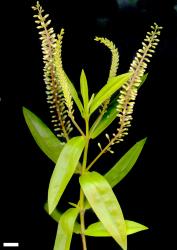- ≡ Hebe pubescens (Benth.) Cockayne & Allan, Trans. New Zealand Inst. 57: 17 (1926)
Bushy shrub to 2 m tall. Stems usually erect, sometimes sub-erect to spreading, eglandular-puberulent to -pubescent; hairs uniform. Leaf bud distinct, its leaves appressed at margins until fully grown; sinus small, square, oblong, rounded or acute. Leaves opposite-decussate, erecto-patent to recurved; lamina sub-coriaceous or coriaceous, linear, lanceolate, ovate, elliptic, oblong, or oblanceolate, 15–125 mm long, 3.5–31.0 mm wide, dull to glossy dark to yellowish-green above, dull pale green to green beneath; midrib evident, secondary veins sometimes evident when fresh; surfaces with eglandular hairs along and near midrib above and often beneath, sometimes hairy all over or glabrous beneath; margin sparsely to densely ciliate to sometimes puberulent to pubescent, entire; apex sub-acute to obtuse; base cuneate to truncate; petiole 0.5–4.0 mm long. Inflorescence a lateral raceme, 20–200 mm long; flowers crowded, 20–190, all bisexual, or female or bisexual on separate plants in some populations, ⚥ > ♀; bracts alternate, narrowly deltoid to lanceolate, usually < to sometimes = or slightly > pedicels; pedicels erecto-patent to spreading, sometimes recurved at fruiting, 0.8–5.0 mm long, eglandular-puberulent or -pubescent all around. Calyx lobes 4, sub-acute to acuminate, 1.8–3.0 mm long, equal to sub-equal, glabrous or eglandular-hairy on surfaces, mixed eglandular- and glandular-ciliolate on margins. Corolla 4–11 mm diameter; tube white, 1.9–5.5 mm long, ≤ to slightly > calyx, eglandular-hairy inside and often outside; lobes 4, white or pale purplish, sub-erect to spreading, unequal, lanceolate, elliptic, ovate, or narrowly oblong, 2–6 mm long; nectar guides absent. Stamen filaments white, 4.5–6.0 mm long; anthers magenta to purple. Style glabrous or eglandular hairy, 3.5–10.5 mm long. Capsules latiseptate, sub-acute to obtuse, glabrous or eglandular-hairy, 3–6 mm long, 2.0–3.4 mm at widest point. Seeds ellipsoid, flattened, smooth, straw-yellow to pale brown, 1.0–2.5 mm long.
| 1 | Leaf hairs long (>0.2 mm) and fringing on margins and midribs beneath, often also on lower leaf surface (Coromandel Peninsula and nearby islands) | subsp. pubescens |
| Leaf hairs short (<0.2 mm) and ciliolate on margins and puberulent or glabrous on midribs beneath | 2 | |
| 2 | Leaves mostly broadest below midpoint, lanceolate or linear-lanceolate (Great Barrier I. [Aotea I.] and nearby islands) | subsp. rehuarum |
| Leaves mostly broadest above midpoint, oblanceolate to obovate (Te Hauturu-o-Toi / Little Barrier I., Mokohinau Is.) | subsp. sejuncta |
The presence of a small sinus distinguishes V. pubescens plants from similar species, and the presence of long hairs on petioles, lamina beneath, and midribs and margins distinguishes mainland plants (subsp. pubescens) from species such as V. stricta and V. macrocarpa, which grow in the same area. Recognition of the subspecies and their differences from similar species are discussed under those entries.
The corolla is often sparsely pubescent on the outer faces of the lobes, but may also be glabrous.
North Island: Auckland (in the east, mostly Coromandel Peninsula and eastern islands).
Often coastal in open forest and scrub, rock outcrops and cliffs, sometimes in forest; inland on disturbed and regenerating sites.
| Category | Number |
|---|---|
| Indigenous (Endemic) | 3 |
| Total | 3 |
Flowers: January–December; fruits: January–December.
2n = 40 (see Bayly & Kellow 2006, as Hebe pubescens).
Veronica pubescens is classified in V. subg. Pseudoveronica sect. Hebe and the informal group “Apertae” (large-leaved) (Albach & Meudt 2010; Bayly & Kellow 2006).
The frequency of female plants and the populations they occur in are not known (Bayly & Kellow 2006), and it is likely that most populations are cosexual.




